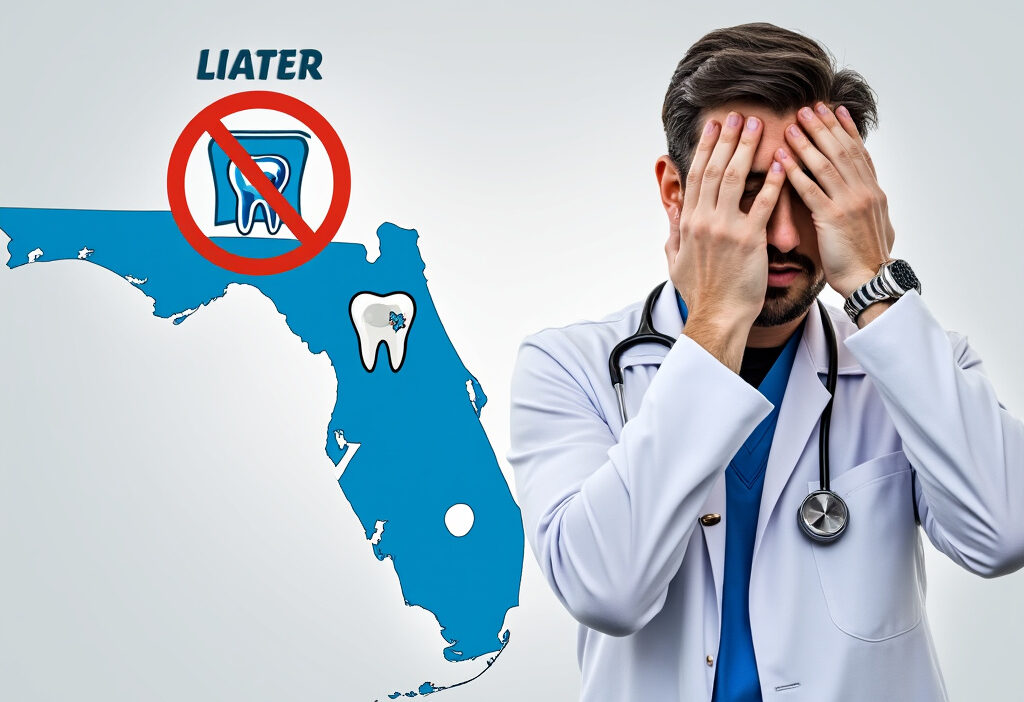Florida’s Groundbreaking Move: Banning Fluoride in Public Water
In an unprecedented policy shift, Florida has become the second state in the U.S. to ban fluoride from public water systems, following Utah’s lead. This decision by Governor Ron DeSantis has ignited a broad debate surrounding public health, personal choice, and the long-established practice of water fluoridation. This article delves into the various facets of the ban, including the reasons behind the decision, responses from local governments, and the potential impact on public health.
The Genesis of Water Fluoridation
Water fluoridation traces its origins to early 20th-century research, when scientists observed lower rates of tooth decay in regions with naturally occurring fluoride in water. This discovery led to controlled fluoridation trials, beginning with Grand Rapids, Michigan, in 1945—the first city to adjust fluoride levels in its public water supply. The goal was simple: reduce cavities, particularly among children and underserved communities with limited access to dental care.
The science behind fluoridation hinges on fluoride’s ability to remineralize tooth enamel and inhibit bacterial acid production. By the 1950s, the practice gained endorsement from the U.S. Public Health Service, followed by the World Health Organization (WHO) and the American Dental Association (ADA). Today, over 70% of U.S. public water systems fluoridate their water, aligning with CDC guidelines that label it one of the top 10 public health achievements of the 20th century.
Globally, fluoridation policies vary. Countries like Australia and Ireland embrace it, while others, such as much of Europe, rely on fluoridated salt or topical treatments. Despite controversies, major health organizations maintain that optimally fluoridated water (0.7 ppm) is safe and effective—a stance now challenged by Florida’s unprecedented ban.
The Policy Shift in Florida
In a significant policy shift, Florida recently joined Utah as the second state to ban fluoride from public water supplies. The decision, signed into law by Governor Ron DeSantis in early 2024, marks a departure from decades of public health precedent. The legislative process moved swiftly, with the bill passing the state House and Senate along party lines after heated debates. Key proponents, including Republican lawmakers, framed the ban as a victory for personal freedom, arguing that fluoridation constitutes government overreach into individual health choices.
The state government’s rationale centered on concerns about forced medication, echoing libertarian arguments against mass fluoridation. DeSantis emphasized parental rights, stating that families should decide whether their children consume fluoride, not the state. Critics, however, pointed to the lack of scientific consensus supporting the ban, noting that organizations like the CDC and WHO still endorse fluoridation for cavity prevention.
The law includes provisions allowing local municipalities to opt out of fluoridation immediately, with a full statewide phase-out by 2025. This move has sparked intense discussions about the balance between public health mandates and individual autonomy, setting the stage for broader debates in other states considering similar measures.
Government and Public Reactions
The ban on fluoride in Florida’s public water systems has sparked a heated debate, drawing sharp reactions from local governments, health experts, and residents. Miami-Dade County commissioners were among the first to voice opposition, arguing that the move undermines decades of proven dental health benefits, particularly for low-income communities. Meanwhile, supporters of the ban, including some conservative advocacy groups, applaud the decision as a win for personal choice, framing fluoride as a chemical that individuals should opt into rather than be exposed to involuntarily.
Public health officials have expressed concern, with the Florida Dental Association warning of a potential rise in cavities and oral health disparities. Social media has amplified the divide, with some residents celebrating the ban as a step toward “cleaner water,” while others fear it will disproportionately affect children and marginalized populations. Local governments now face the logistical challenge of adjusting water treatment protocols, with some municipalities considering supplemental fluoride programs—a costly alternative. The discourse reflects a broader tension between individual freedoms and collective health measures, leaving Florida at the center of a national conversation about the role of government in public wellness.
Public Health Implications
The removal of fluoride from Florida’s public water systems raises significant concerns among dental and public health experts, who warn of potential long-term consequences for oral health. Decades of scientific research, including studies by the Centers for Disease Control and Prevention (CDC), have demonstrated that water fluoridation reduces tooth decay by 25% in children and adults. Without this preventive measure, Florida may see a rise in cavities, particularly in low-income communities where access to dental care is limited.
Dental associations, including the American Dental Association (ADA), argue that fluoridation is a cost-effective public health intervention, saving an estimated $32 per person annually in avoided dental treatments. Opponents of the ban fear it will disproportionately affect vulnerable populations, exacerbating existing health disparities. However, critics of fluoridation cite concerns over potential overexposure and individual choice, though mainstream science maintains that optimally fluoridated water (0.7 mg/L) is safe and beneficial.
The shift may also strain Florida’s healthcare system, as increased dental issues could lead to higher Medicaid costs and emergency room visits for preventable conditions. Public health advocates stress the need for alternative interventions, such as school-based fluoride programs, to mitigate the ban’s impact.
The Broader National Context
Florida’s decision to ban fluoride in public water aligns with a growing but still niche movement in the U.S., with Utah being the only other state to implement a similar statewide prohibition. While Utah’s ban, enacted in 2000, was driven by libertarian concerns over government-mandated medication, Florida’s move appears more influenced by recent debates over health risks and individual choice. Nationally, water fluoridation remains widespread, with the CDC reporting that over 70% of Americans receive fluoridated water. However, localized opposition is gaining traction. States like Oregon and New Hampshire have seen legislative pushes to end fluoridation, though none have succeeded yet.
The trend reflects a broader shift in public health policy, where skepticism toward mass interventions clashes with established scientific consensus. While organizations like the ADA and WHO continue endorsing fluoridation, grassroots campaigns—often fueled by misinformation—are pressuring local governments to reconsider. Some cities, such as Portland, Oregon, have resisted fluoridation for decades, while others, like Juneau, Alaska, repealed it after cost-benefit analyses. Florida’s ban may embolden similar efforts elsewhere, particularly in states with strong anti-regulation sentiments. Yet, the long-term impact on dental health disparities, as seen in Utah’s higher cavity rates, could deter widespread adoption. The national landscape remains divided, with Florida’s move marking a pivotal moment in this ongoing debate.
Understanding the Opposition
Opposition to water fluoridation has long been rooted in concerns about health risks, ethical dilemmas, and contested scientific findings. Critics argue that fluoride, even at low concentrations, may lead to overexposure, particularly for children, citing studies linking excessive fluoride intake to dental fluorosis—a condition causing tooth discoloration. More controversially, some research suggests a potential correlation between fluoride exposure and lower IQ in children, though these studies remain hotly debated within the scientific community.
Ethical objections also play a significant role, with opponents framing fluoridation as mass medication without individual consent. Groups like the Fluoride Action Network argue that public water systems should not be used to deliver medical interventions, emphasizing personal autonomy over government-mandated health measures. Some libertarian and natural health advocates echo this sentiment, viewing fluoridation as an overreach of public health authority.
Additionally, skeptics question the necessity of fluoridation in modern times, pointing to the widespread availability of fluoride toothpaste and professional dental treatments. They argue that these alternatives render water fluoridation redundant, allowing individuals to control their own exposure. As Florida joins Utah in banning fluoride, these opposition arguments gain renewed traction, shaping a contentious debate over public health priorities.
The Role of Personal Choice in Public Health
The debate over water fluoridation often centers on the tension between public health mandates and individual autonomy. While proponents argue fluoride is a cost-effective way to reduce cavities, especially in underserved communities, critics frame its addition as a form of compulsory medication, raising ethical questions about consent. Unlike vaccines, which are administered individually, fluoridation affects entire populations regardless of personal preference—blurring the line between collective benefit and bodily sovereignty.
This dilemma reflects broader philosophical shifts in how health is defined. Modern frameworks emphasize holistic well-being, not just disease prevention, placing greater weight on personal agency. For instance, bans on sugary drinks in schools or smoking restrictions balance public good with choice, but fluoridation uniquely lacks opt-out mechanisms. Some argue that informed consent should apply to public water, given emerging research on fluoride’s potential neurocognitive risks. Others counter that removing it disproportionately harms low-income families reliant on communal prevention.
The Florida ban forces a reckoning: Should public health prioritize uniform interventions or accommodate diverse risk tolerances? As alternatives like topical fluoride gain traction, the discussion may pivot toward targeted solutions—preserving dental benefits while respecting individual boundaries.
Alternative Dental Health Strategies
With Florida banning fluoride from public water, the focus shifts to alternative strategies for preventing tooth decay. Salt fluoridation is one option, widely used in countries like Switzerland and Germany. This method allows individuals to choose fluoridated salt, balancing public health benefits with personal choice. However, its effectiveness depends on widespread adoption, and in the U.S., where salt consumption is already scrutinized for health reasons, this may face resistance.
Topical fluoride applications, such as toothpaste, mouth rinses, and professional treatments, offer targeted protection. These methods are proven effective, particularly for high-risk groups, but rely on consistent access and compliance—a challenge for low-income populations who may struggle with affordability or dental care access.
Educational programs promoting dental hygiene can complement these measures. Initiatives like school-based sealant programs or community outreach have shown success in reducing cavities, especially in underserved areas. However, their long-term impact depends on sustained funding and public engagement.
Globally, alternatives like milk fluoridation (used in some parts of the UK and Chile) or fluoride tablets demonstrate flexibility, but their scalability in the U.S. remains untested. The viability of these alternatives hinges on infrastructure, cultural acceptance, and equitable distribution—key factors as Florida navigates the fallout of its fluoride ban.
The Economic and Social Impact of Fluoride Bans
The economic and social ramifications of Florida’s fluoride ban are significant, particularly for vulnerable populations. Local governments may face immediate cost savings from halting fluoridation, but these could be offset by rising public health expenses. Studies show that every dollar spent on water fluoridation saves approximately $38 in dental treatment costs, meaning the ban could strain Medicaid and low-income dental programs as cavities and related conditions increase.
For low-income families, the impact could be severe. Without affordable access to alternative fluoride treatments—discussed in the previous chapter—dental health disparities may widen. Private dental care is often unattainable for these groups, leaving them reliant on underfunded public health initiatives. Schools in disadvantaged areas might see higher absenteeism due to untreated tooth decay, further exacerbating educational inequalities.
Socially, the ban could deepen divides in oral health outcomes. Wealthier communities can offset the loss of fluoridated water with fluoride toothpaste, rinses, or professional treatments, while others cannot. Dental health, already tied to socioeconomic status, may become another marker of inequality. As debates over public health policy intensify—as explored in the next chapter—the economic and social fallout from this decision will likely fuel further scrutiny of Florida’s approach.
Looking Ahead
Florida’s decision to ban fluoride in public water could reshape public health policy debates far beyond its borders. By joining Utah in eliminating fluoride, the state has reignited discussions about the balance between government intervention and personal autonomy in health care. This move may embolden other states to reconsider fluoridation, particularly those with strong anti-interventionist sentiments, potentially fragmenting national public health standards.
Long-term, the ban could accelerate a shift toward localized health policies, where states or municipalities tailor public health measures to ideological preferences rather than scientific consensus. This decentralization might lead to wider disparities in dental health outcomes, especially if neighboring states maintain fluoridation. The debate could also spill into other public health initiatives, such as vaccine mandates or nutrition programs, as critics leverage Florida’s precedent to challenge top-down health policies.
On a national level, the ban may force federal agencies like the CDC to reassess their fluoridation guidelines or face growing skepticism. If dental health declines in Florida, it could become a case study for both proponents and opponents of fluoride, further polarizing the issue. Ultimately, this decision may redefine how public health priorities are negotiated in an era of increasing distrust in institutional authority.

Conclusions
The fluoride ban in Florida marks a significant departure from decades of public health policy aimed at reducing tooth decay through water fluoridation. By prioritizing personal choice over collective health measures, Florida’s new law could set a precedent, influencing future public health decisions and sparking further debate. This development raises important questions about the balance between individual liberty and community health needs.



